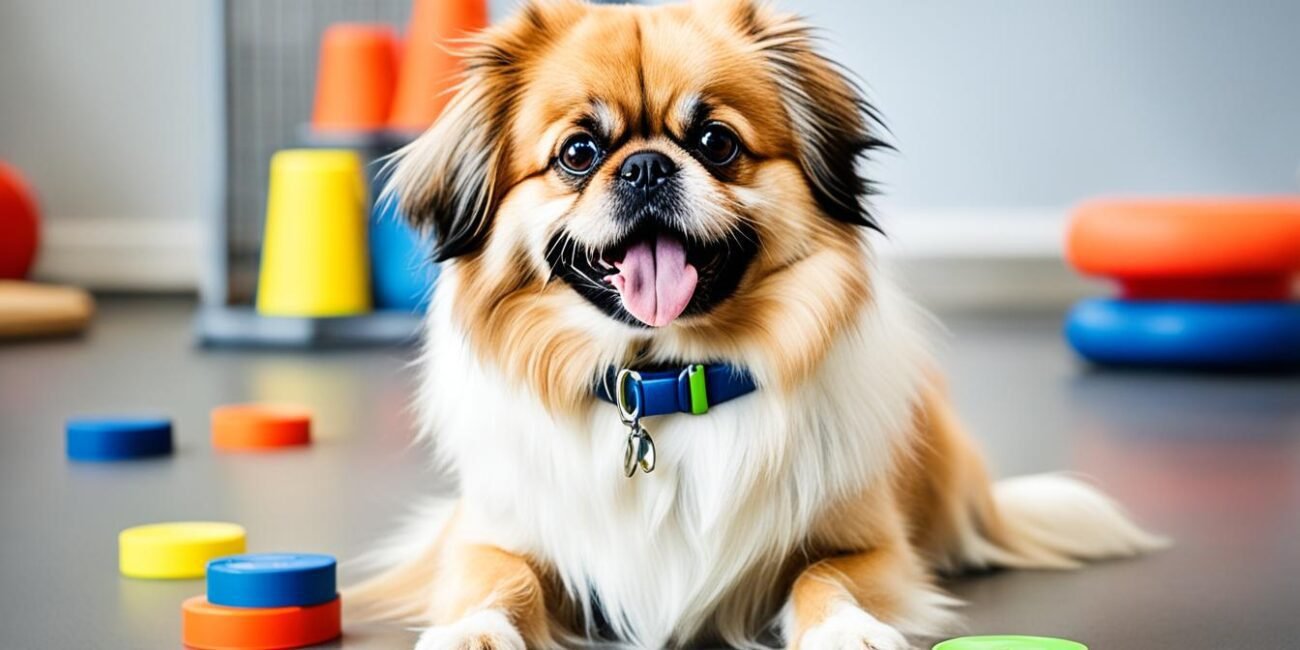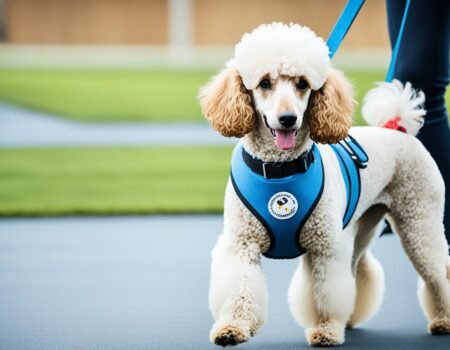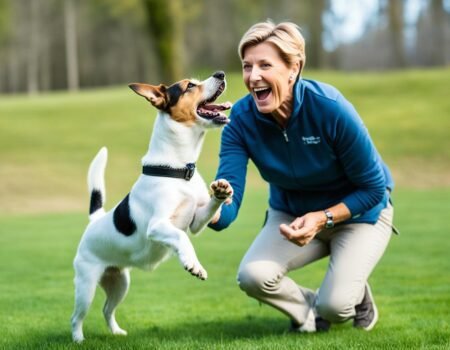Training a Pekinese can be a journey filled with unique challenges and rewards. As someone who has experienced the joy and frustration that comes with training these adorable but stubborn little dogs, I understand the importance of finding effective training methods that cater specifically to their needs.
In this Pekinese training guide, we will dive deep into the world of training these lovable furballs. Whether you’re a seasoned dog owner or a first-time Pekinese parent, our expert tips and tricks will provide you with the knowledge and tools to successfully train your Pekinese.
From housebreaking issues to obedience problems and behavioral challenges, we will cover it all. Our goal is to help you establish a strong bond with your Pekinese and create a loving, well-behaved companion that brings you endless joy.
So, let’s embark on this training journey together and unlock the secrets to training your Pekinese like a pro!
Key Takeaways:
- Understand the unique behavior and temperament of Pekinese dogs
- Utilize effective housebreaking techniques for Pekinese
- Master obedience training with positive reinforcement
- Learn the art of leash training for a safe and enjoyable walk
- Discover the benefits of crate training for Pekinese
Understanding Pekinese Behavior and Temperament
Before embarking on the training journey with your Pekinese, it’s crucial to gain insight into their unique behavior and temperament. Pekinese dogs are known for their independent nature, stubbornness, and a hint of aloofness. However, underneath their seemingly aloof exterior, they possess intelligence, loyalty, and a profound capacity for love. Successfully training a Pekinese requires a gentle and patient approach that takes into account their distinctive characteristics.
By comprehending the behavior and temperament of your Pekinese, you can tailor your training techniques to effectively communicate with them and address any behavioral issues that may arise. It’s important to remember that each Pekinese is an individual with their own personality quirks, so flexibility in your training approach is key to achieving desired results.
Key Traits of Pekinese Behavior and Temperament
- Independent: Pekinese dogs are known to have a strong sense of independence, which can sometimes make them appear aloof or disinterested. However, this independence should not be mistaken for indifference.
- Stubbornness: Pekinese are proud and intelligent dogs, which can make them stubborn at times. Patience and perseverance are essential when training a Pekinese, as they may require more time and encouragement to master new skills.
- Loyalty: Despite their independent nature, Pekinese are incredibly loyal to their owners. Developing a strong bond based on trust and mutual respect is crucial for successful training.
- Affectionate: Pekinese dogs have a deep capacity for love and affection towards their families. Building a positive and loving training environment will help motivate and inspire your Pekinese to learn and grow.
- Protective: Pekinese dogs are often fiercely protective of their loved ones. While this can be a desirable trait, it’s important to guide and channel their protective instincts appropriately through training.
To effectively train a Pekinese, it’s vital to approach their behavior and temperament with understanding and empathy. By tapping into their intelligence, loyalty, and affectionate nature, you can create a harmonious training experience that fosters a strong bond between you and your furry companion.
“Training a Pekinese requires a gentle and patient approach that takes into account their unique behavior and temperament.”
Throughout this training guide, we will delve deeper into various training techniques and strategies that are most effective for Pekinese dogs. From housebreaking and obedience training to leash training and advanced commands, each section will provide you with valuable insights and practical tips to help you navigate the training process with confidence and success.
Remember, building a solid foundation of understanding your Pekinese’s behavior and temperament is the first step towards creating a well-trained and balanced companion. Let’s dive into the wonderful world of Pekinese dog training and discover the joys of nurturing a lifelong bond with your furry friend!
Housebreaking a Pekinese
Housebreaking or potty training is often one of the first challenges dog owners face. Pekinese can be difficult to housebreak due to their stubborn nature. However, with consistency and positive reinforcement, you can successfully housebreak your Pekinese.
Here are some effective methods to help you with housebreaking your Pekinese:
- Crate Training: Utilize a crate to create a designated area for your Pekinese to eliminate. Pekinese naturally avoid soiling their sleeping space, making crate training an effective method for housebreaking.
- Establish a Routine: Developing a consistent schedule for feeding and bathroom breaks will help your Pekinese understand when and where they should eliminate. Take your dog outside first thing in the morning, after meals, and before bed.
- Positive Reinforcement Techniques: Reward your Pekinese with praise and treats when they eliminate in the appropriate spot. This positive reinforcement establishes a positive association and encourages your dog to repeat the behavior.
- Closely Supervise: Keep a close eye on your Pekinese during the housebreaking process. If you notice any signs that your dog needs to go, such as sniffing or circling, immediately take them to the designated elimination area.
Remember that housebreaking a Pekinese requires patience and consistency. Accidents may happen during the training process, but it’s important not to punish or scold your dog. Instead, reinforce positive behavior and continue following the training methods until your Pekinese is fully housebroken.
“Consistency and positive reinforcement are key when housebreaking a Pekinese.”
Obedience Training for Pekinese
When it comes to training your Pekinese, obedience training is a crucial aspect that shouldn’t be overlooked. By teaching your Pekinese basic commands such as sit, stay, come, and leave it, you can establish a strong foundation of discipline and communication.
Positive reinforcement methods work particularly well with Pekinese dogs. Using treats and praise as rewards can motivate and encourage your Pekinese to respond to your commands effectively. Remember to be patient and consistent throughout the training process, as Pekinese dogs may take longer to learn and respond to commands compared to other breeds.
Here are some key tips for successful obedience training with your Pekinese:
- Start training at a young age: Begin obedience training as early as possible to establish good habits and behaviors.
- Use positive reinforcement: Reward your Pekinese with treats, verbal praise, and affection when they obey your commands correctly.
- Keep training sessions short and frequent: Pekinese dogs have short attention spans, so it’s best to keep the training sessions brief but consistent.
- Be patient and consistent: Pekinese dogs may require more time and repetition to grasp new commands, so stay patient and avoid getting frustrated.
- Practice in different environments: Gradually expose your Pekinese to various settings and distractions to ensure they can follow commands in different situations.
Remember, obedience training is an ongoing process. As your Pekinese becomes more comfortable with basic commands, you can gradually progress to more advanced training techniques. Stay dedicated and consistent, and you’ll develop a strong bond with your Pekinese while enjoying the benefits of a well-trained and obedient furry companion.
Expert Tip:
Consistency is key when it comes to obedience training. Make sure all family members are on the same page and use the same commands and training techniques. This will help your Pekinese understand and respond consistently to everyone in the household.
| Command | Training Technique |
|---|---|
| Sit | Hold a treat above your Pekinese’s head and gently guide them into a sitting position. Reward them with the treat and praise when they sit. |
| Stay | Start by having your Pekinese sit, then use a hand gesture or verbal cue such as “stay” while taking a step back. If they stay put, reward them with a treat and praise. |
| Come | Use a happy and enthusiastic tone of voice while calling your Pekinese’s name followed by the command “come.” When they come to you, reward them with a treat and lots of praise. |
| Leave it | Hold a treat in your closed hand and say “leave it” while keeping your hand closed. Wait for your Pekinese to lose interest or turn away, then reward them with a different treat and praise. |
To ensure successful obedience training, remember to provide a positive and nurturing environment for your Pekinese. With patience, consistency, and the right training techniques, you’ll be on your way to having a well-behaved and obedient Pekinese.
Leash Training for Pekinese
Leash training plays a crucial role in ensuring the safety of both you and your Pekinese during walks. Due to their small size, Pekinese dogs can easily become overwhelmed or distracted while on a leash. With effective training techniques and patience, you can teach your Pekinese to walk calmly on a leash.
When introducing your Pekinese to the leash, it’s important to use positive reinforcement and rewards to encourage good behavior. Start by allowing your Pekinese to sniff and explore the leash in a calm environment. Gradually attach the leash to your Pekinese’s harness or collar while providing treats and praise. This positive association will help your Pekinese view the leash as something enjoyable.
Begin with short walks in a quiet area where there are minimal distractions. Use treats and verbal cues to encourage your Pekinese to walk beside you. If your Pekinese pulls or becomes too excited, stop and wait until they calm down before proceeding. Consistency is key during leash training, so maintain a calm and patient demeanor throughout the process.
As your Pekinese becomes more comfortable with leash walking, gradually increase the duration and intensity of the walks. Introduce different environments and situations, such as walking in busier areas or encountering other dogs or people. This will help your Pekinese adapt to various scenarios and reinforce their leash training.
Leash Training Tips for Pekinese:
- Use a lightweight leash that is proportionate to your Pekinese’s size.
- Choose a comfortable and secure harness or collar for your Pekinese.
- Use positive reinforcement, such as treats and praise, to reinforce good leash behavior.
- Start with short walks in quiet areas and gradually increase the complexity of the environment.
- Be patient and consistent, as Pekinese may take time to adjust to leash training.
Training Troubleshooting:
“My Pekinese keeps pulling on the leash during walks. What should I do?”
When your Pekinese pulls on the leash, stop immediately and wait for them to calm down. Once they settle, continue walking. This will teach your Pekinese that pulling results in a loss of forward movement, incentivizing them to walk calmly beside you. Consistency and patience are key to overcoming this challenge.”
| Common Leash Training Challenges | Effective Solutions |
|---|---|
| Pulling on the leash | Stop walking and wait for your Pekinese to calm down before proceeding. Consider using a front-clip harness to discourage pulling. |
| Barking or lunging at other dogs | Redirect your Pekinese’s attention with treats or toys. Practice obedience commands, such as “sit” or “leave it,” to discourage reactive behavior. |
| Becoming easily distracted during walks | Use high-value treats and positive reinforcement to keep your Pekinese focused on you. Practice in quiet environments before gradually increasing distractions. |
By following these leash training tips and troubleshooting common challenges, you can ensure enjoyable and safe walks with your Pekinese. Remember, patience and consistency are key when training your Pekinese on a leash.
Crate Training for Pekinese
When it comes to training your Pekinese, crate training can be an invaluable tool. Crate training serves multiple purposes, including housebreaking and providing a safe and secure space for your dog. By following the right techniques and methods, you can make crate training a positive experience for your Pekinese.
First, it’s important to choose a crate that is the appropriate size for your Pekinese. The crate should be large enough for your dog to stand, turn around, and lie down comfortably. A crate that is too big may encourage your Pekinese to eliminate in one corner and sleep in another, defeating the purpose of crate training.
Next, make the crate a cozy and inviting space for your Pekinese. Place soft bedding inside the crate to provide comfort. You can also add a familiar toy or blanket to help your dog feel at ease. Creating a positive association with the crate will make it more appealing to your Pekinese.
To introduce your Pekinese to the crate, use positive reinforcement techniques. Start by leaving the crate door open and placing treats or toys inside. Encourage your Pekinese to explore the crate on their own terms. Avoid forcing your dog into the crate or closing the door too soon, as this may create anxiety.
Once your Pekinese is comfortable entering the crate, gradually begin closing the door for short periods of time. Stay nearby and offer praise and rewards for calm behavior. Gradually increase the duration that your Pekinese spends in the crate, always ensuring they have a positive experience.
Using the crate for housebreaking can be particularly effective. Dogs naturally avoid soiling their sleeping area, so the crate can help establish good bathroom habits. Take your Pekinese outside to eliminate immediately after being let out of the crate. This reinforces the connection between going outside and using the bathroom.
Crate training also helps establish a routine for your Pekinese. Dogs thrive on routine and the consistency provided by crate training can help prevent destructive behavior and promote a sense of security.
| Benefits of Crate Training for Pekinese | Tips for Successful Crate Training |
|---|---|
|
|
Crate training can be a valuable part of your overall training plan for your Pekinese. Remember to always use positive reinforcement, patience, and consistency to ensure a successful crate training experience for your furry friend.
Behavior Training for Pekinese
Behavior training plays a crucial role in addressing and correcting undesirable behaviors in Pekinese dogs. Common behavioral issues in Pekinese include excessive barking, aggression, and separation anxiety. With the right training techniques and strategies, you can effectively modify your Pekinese’s behavior and promote desirable habits.
One of the most effective techniques in behavior training is positive reinforcement. This involves rewarding your Pekinese with treats, praise, or playtime when they exhibit good behavior. Positive reinforcement helps reinforce positive associations and encourages your Pekinese to repeat desirable actions.
“Positive reinforcement is a powerful tool in behavior training. By rewarding your Pekinese for good behavior, you can effectively shape their behavior and strengthen the bond between you and your furry friend.”
Consistency is essential in behavior training. Establish clear rules and expectations for your Pekinese and ensure that everyone in the household follows them consistently. Inconsistent rules can confuse your Pekinese and hinder their progress in behavior training.
Patience is also key when training your Pekinese. Behavior issues cannot be resolved overnight, and it may take time for your dog to understand and adapt to the new desired behaviors. Stay calm, patient, and persistent throughout the training process.
If you’re facing significant behavioral challenges with your Pekinese, it may be beneficial to seek the guidance of a professional dog trainer or behaviorist. They can provide expert advice and personalized training plans to address specific behavioral issues and support you in training your Pekinese effectively.
Remember, behavior training requires time, commitment, and a positive mindset. With the right techniques and strategies, you can shape your Pekinese’s behavior and develop a well-behaved and happy companion.
| Behavior Training Tips for Pekinese |
|---|
| 1. Use positive reinforcement to reward good behavior. |
| 2. Be consistent with your training rules and expectations. |
| 3. Practice patience and persistence in behavior training. |
| 4. Seek professional guidance for significant behavioral challenges. |
Advanced Training for Pekinese Dogs
Once you have mastered basic obedience and behavior training with your Pekinese, it’s time to take their training to the next level. Advanced training provides mental stimulation for your intelligent Pekinese and strengthens the bond between you and your furry companion.
During advanced training, you can teach your Pekinese various tricks, engage them in agility training, or even explore specialized tasks. These activities not only challenge your dog’s mind but also provide an opportunity for them to showcase their unique skills and abilities.
When it comes to advanced training techniques for Pekinese, positive reinforcement remains key. Reward your Pekinese with treats, praise, and affection whenever they successfully perform a trick or complete an agility course. This positive feedback encourages their continued progress and motivates them to excel in their training.
Keep in mind that advanced training requires patience and consistency. Break down complex tricks or tasks into smaller, more manageable steps. Gradually increase the difficulty level as your Pekinese masters each step. Remember to celebrate every small achievement along the way, as it will boost your dog’s confidence and enthusiasm.
As you embark on your Pekinese’s advanced training journey, always prioritize their safety and well-being. Ensure that the tricks or tasks you teach them are appropriate for their size, age, and physical abilities. Avoid exerting too much pressure or forcing your Pekinese to perform beyond their limits.
Advanced training is not only about developing new skills but also deepening the bond between you and your Pekinese. It’s a time for both of you to have fun, learn together, and further strengthen your partnership.
Remember, just like humans, dogs thrive when they are mentally and physically stimulated. Advanced training offers a fulfilling experience for your Pekinese by providing them with the opportunity to showcase their intelligence, agility, and uniqueness. Enjoy this special journey of advanced training with your beloved Pekinese!
Key Takeaways
- Advanced training for Pekinese dogs involves teaching them tricks, engaging in agility training, or exploring specialized tasks.
- Positive reinforcement techniques, such as treats and praise, are essential for motivating and rewarding Pekinese during advanced training.
- Break down complex tricks or tasks into smaller, manageable steps to ensure your Pekinese can master them successfully.
- Always prioritize the safety and well-being of your Pekinese during advanced training and choose activities that are suitable for their size and physical abilities.
- Advanced training is an opportunity to deepen the bond between you and your Pekinese while providing them with mental and physical stimulation.
The Importance of Proper Nutrition and Exercise
Proper nutrition and exercise are crucial for the overall health and well-being of your Pekinese. As responsible pet owners, it is our duty to ensure that our furry friends receive the necessary nutrients and physical activity to thrive.
Proper Nutrition for Pekinese
When it comes to feeding your Pekinese, it is important to provide a balanced diet that meets their nutritional needs. A high-quality dog food specifically formulated for small breeds, like Pekinese, is an excellent choice. Look for foods that contain real meat as the primary ingredient and avoid those with excessive fillers or artificial additives.
Portion control is crucial to prevent overfeeding and obesity. Follow the recommended feeding guidelines provided by the manufacturer, but also consider your Pekinese’s age, weight, and activity level. It’s always best to consult with your veterinarian to determine the appropriate portion size for your specific Pekinese.
Exercise for Pekinese Dogs
Regular exercise is essential for maintaining the physical and mental well-being of your Pekinese. Despite their small size, these dogs have a lot of energy and need daily opportunities to burn it off. Engaging in physical activities not only keeps them fit but also stimulates their minds and prevents boredom.
Take your Pekinese for daily walks, ideally twice a day, to provide them with the exercise they need. Keep the walks interesting by exploring different routes or environments. Additionally, interactive play sessions, such as fetch or tug-of-war, can be great ways to keep your Pekinese entertained and active.
“Regular exercise is essential for maintaining the physical and mental well-being of your Pekinese.”
Remember to consider the specific needs of your individual Pekinese. For example, older or less active Pekinese may require less exercise, while younger or more energetic ones may need additional playtime or activities.
Incorporating both physical and mental stimulation into your Pekinese’s daily routine will help prevent behavioral issues that can arise from boredom or excess energy. It’s important to strike a balance between proper exercise, mental stimulation, and rest to keep your Pekinese happy and healthy.
By providing your Pekinese with a balanced diet and regular exercise, you are setting them up for a lifetime of good health. A healthy and energetic Pekinese is more likely to engage in training sessions and respond positively to training techniques, leading to a well-behaved and happy companion.
Choosing the Right Training Resources
When it comes to training your Pekinese, it’s essential to have the right resources that align with your training goals and methods. With the plethora of options available, it can be overwhelming to choose the most suitable ones. That’s why we’ve compiled a list of considerations to help you make an informed decision.
Reputable Trainers
Look for reputable trainers who specialize in Pekinese training. These professionals have extensive experience working with this breed and can provide valuable insights and guidance. Check their credentials, certifications, and reviews from other dog owners to ensure you are choosing a reliable training expert.
Online Courses
Online courses offer the convenience of learning at your own pace and from the comfort of your home. Look for courses specifically tailored to Pekinese training. Ensure that the courses cover a wide range of topics, such as obedience training, behavior training, and advanced training techniques.
Books
Books are an excellent resource for in-depth knowledge and step-by-step training methods. Look for well-reviewed books written by dog trainers who have experience with Pekinese dogs. These books should provide detailed instructions, illustrations, and troubleshooting tips to help you navigate the training process.
Videos
Videos can be a valuable training resource, as they allow you to visually observe training techniques in action. Look for reputable dog trainers who offer instructional videos specifically for Pekinese training. These videos should cover a variety of training topics and demonstrate effective techniques.
Remember, finding the right training resources is crucial to ensure a positive and effective training experience for both you and your Pekinese. Take the time to research and choose resources that align with your training goals and provide reliable and efficient training techniques specifically designed for Pekinese dogs.
Troubleshooting Common Training Challenges
Every dog training journey comes with its own set of challenges. It’s important to anticipate and troubleshoot common training issues that may arise with your Pekinese. These can include stubbornness, lack of motivation, distractions, or regression. By being proactive and seeking guidance from experienced trainers or behaviorists, you can overcome these challenges and continue making progress with your Pekinese training.
When it comes to training your Pekinese, it’s essential to have a clear understanding of their unique behavioral traits and temperaments. Their independent and sometimes stubborn nature can pose challenges during the training process. However, with the right training methods and techniques, you can effectively address these challenges and achieve desired results.
One common challenge that Pekinese owners face is stubbornness. Pekinese are known for being strong-willed and independent, which can make training sessions frustrating at times. When dealing with stubbornness, it’s crucial to remain patient and consistent. Use positive reinforcement techniques, such as treats and praise, to incentivize desired behaviors. Break training tasks into smaller, more manageable steps to prevent overwhelming your Pekinese and increase their chances of success.
Lack of motivation is another issue that may arise during the training process. Pekinese dogs, like any other breed, may not always be in the mood for training. To tackle this challenge, it’s important to make training sessions fun and engaging. Use interactive toys, games, and rewards to stimulate their interest and motivation. Incorporating variety into their training routine can also help keep them engaged and eager to learn.
Distractions can pose a significant challenge when training Pekinese dogs. Their curious nature can easily lead them astray during training sessions. To overcome distractions, start training in a quiet and familiar environment. Gradually introduce distractions, such as noise or other animals, once your Pekinese has mastered basic commands. Use high-value treats or toys to regain their attention and reinforce focus during training.
Regression is another common issue experienced during Pekinese training. After making progress in certain areas, your Pekinese may exhibit regression in their behavior or obedience. This can be frustrating for owners, but it’s important not to get discouraged. Regression is a normal part of the training process, and it’s often a sign that your Pekinese is testing boundaries. Stay consistent with training and reinforce previously learned behaviors to help your dog regain their previous level of proficiency.
Remember, professional guidance from experienced trainers or behaviorists can be invaluable when troubleshooting training challenges. They can provide personalized advice and techniques tailored to your Pekinese’s specific needs. Don’t hesitate to seek assistance if you encounter significant difficulties during the training process.
By addressing common training challenges head-on and remaining consistent, patient, and positive, you can overcome hurdles and make progress in your Pekinese training journey. Remember that training is an ongoing process that requires dedication and commitment from both you and your Pekinese.
Building a Strong Bond Through Training
Training your Pekinese is an essential part of developing a deep and lasting bond with your furry companion. It goes beyond addressing behavioral issues and teaching commands; it is an opportunity to build trust, improve communication, and enhance the overall relationship between you and your dog.
Through training, you provide mental stimulation for your Pekinese, helping them stay engaged and fulfilled. It allows them to channel their energy and intelligence in a positive and constructive manner. By utilizing effective training techniques tailored specifically for Pekinese, you can keep their mind sharp and create a well-rounded, well-behaved pet.
Obedience training is a vital aspect of building a strong bond with your Pekinese. It establishes clear communication and reinforces your role as the pack leader. By consistently reinforcing desired behaviors with positive reinforcement methods, such as treats and praise, you strengthen the trust and respect between you and your dog.
Remember, training is a journey that requires patience, consistency, and dedication. By investing time and effort into training, you not only shape your Pekinese into a well-behaved and obedient companion but also forge an unbreakable bond based on trust, respect, and unconditional love.
FAQ
What are some effective training methods for Pekinese dogs?
Effective training methods for Pekinese dogs include positive reinforcement techniques, consistency, and patience. Understanding their behavior and temperament is also crucial in tailoring your training approach to their unique needs.
How can I housebreak my Pekinese?
Housebreaking a Pekinese can be achieved through crate training, establishing a routine, using positive reinforcement techniques, and closely supervising your dog during the process. Consistency and patience are key in successfully housebreaking your Pekinese.
What is the best approach to obedience training for Pekinese?
Obedience training for Pekinese should focus on teaching basic commands such as sit, stay, come, and leave it. Positive reinforcement methods, such as treats and praise, work well with this breed. It’s important to be patient and consistent during obedience training.
How do I leash train my Pekinese?
Leash training a Pekinese involves gradually introducing them to the leash, using positive reinforcement and rewards for good behavior. Start with short walks in a quiet environment and gradually increase the duration and intensity of the walks. Patience and consistency are key in leash training.
Is crate training suitable for Pekinese?
Yes, crate training can be effective for Pekinese, especially for housebreaking and providing a safe space for your dog. Use a crate that is the appropriate size, introduce your dog gradually using positive reinforcement, and gradually increase the duration of crate time. Crate training helps establish routine and prevents destructive behavior.
How can I address behavioral issues in my Pekinese?
Behavior training focuses on addressing behavioral issues such as excessive barking, aggression, or separation anxiety. Positive reinforcement, consistency, and patience are key in behavior training. Consult with a professional dog trainer or behaviorist if needed.
What are some advanced training techniques for Pekinese dogs?
Advanced training techniques for Pekinese dogs can include teaching tricks, agility training, or specialized tasks. Pekinese are intelligent and can excel in advanced training with the right techniques and positive reinforcement.
How important is nutrition and exercise for Pekinese?
Proper nutrition and exercise are crucial for the overall health and well-being of your Pekinese. A balanced diet, appropriate portion sizes, and regular exercise contribute to their physical and mental fitness, making them more responsive to training techniques.
How do I choose the right training resources for my Pekinese?
When choosing training resources for your Pekinese, consider their training approach, methodology, and reviews from other dog owners. Look for reputable trainers, online courses, books, or videos that specialize in Pekinese training.
How can I troubleshoot common training challenges with my Pekinese?
It’s important to anticipate and troubleshoot common training issues such as stubbornness, lack of motivation, distractions, or regression. Seek guidance from experienced trainers or behaviorists to overcome these challenges and continue making progress with your Pekinese training.
What is the significance of building a strong bond through training with my Pekinese?
Training your Pekinese goes beyond behavioral shaping and command teaching; it fosters a strong bond and relationship between you and your dog. Training provides mental stimulation, improves communication, and establishes trust, resulting in a well-behaved and loyal companion.










No Comment! Be the first one.